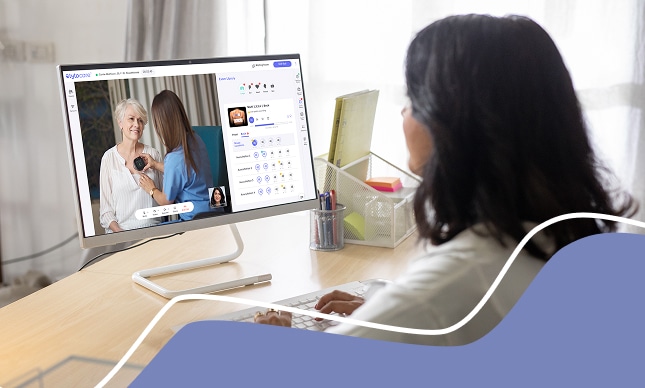Beyond the Buzz: 5 Real Ways AI is Solving Healthcare’s Biggest Bottlenecks

Introduction: Beyond the AI Hype
Artificial intelligence has been the healthcare buzzword of the decade. But while the headlines focus on futuristic promises, health systems across the U.S. are already putting AI to work in very practical, very impactful ways.
The results? Faster patient discharges. More accurate diagnostics. Less clinician burnout. And care that reaches into communities where geography or staffing shortages once stood in the way.
Here are five real-world examples of how AI is solving healthcare’s biggest bottlenecks – not tomorrow, but today.
1. How AI Improves Patient Flow in Hospitals
Hospital capacity remains one of the toughest bottlenecks in U.S. healthcare. Emergency departments are backed up, discharges are delayed, and patients sometimes wait hours or days for a bed.
AI is helping fix this.
- Advocate Health, one of the nation’s largest systems, is rolling out AI to cut clinical documentation time by up to two-thirds, freeing staff to coordinate patient discharges and reduce boarding.
- AI-powered patient flow tools are also being piloted to predict which patients are ready for discharge, ensuring beds open faster for incoming cases.
By automating the administrative side of patient throughput, AI gives clinicians back precious time to focus on care.
2. AI for Remote Diagnostics in Healthcare
Access remains a stubborn barrier especially in rural America, where patients may travel hours for care. AI-driven remote diagnostic tools are helping bridge that gap.
- BJC Health System in St. Louis is embedding AI into telehealth to boost diagnostic accuracy and patient safety during virtual visits.
- Cedars-Sinai Connect (CS Connect) in Los Angeles has already served more than 42,000 patients since 2023. The platform uses AI to guide intake and symptom triage, giving physicians a head start on diagnosis and treatment planning.
Together, these approaches show how AI can scale reach, reduce wait times, and ensure patients get the right care faster.
3. AI Lung Sound Analysis for Clinicians
Respiratory conditions, from asthma to pneumonia, are notoriously difficult to diagnose remotely. AI is stepping in as a powerful clinician assistant.
- A multicenter U.S. study found that non-expert operators using AI-guided lung ultrasound produced diagnostic-quality scans 98.3% of the time, virtually matching expert examiners. That means nurses, medical assistants, and even school staff can now capture specialist-quality images with AI support.
- TytoCare’s FDA-cleared AI lung sound tool builds on a dataset of more than 7 million recordings. During virtual visits, the AI listens for wheezes, crackles, and rhonchi, flagging abnormal sounds in real time for clinician review.
This isn’t replacing the physician’s ear, it’s extending it. AI helps frontline staff and generalists pick up subtle sounds that might otherwise be missed, improving early detection and care planning.
4. Boosting Diagnostic Accuracy and Speed
Radiology has long been under pressure, with U.S. imaging backlogs causing delays in cancer detection and emergency triage. AI is proving to be a valuable ally.
- FDA-cleared tools like Aidoc are being adopted in health systems to prioritize critical findings, such as pulmonary embolisms or strokes, so radiologists can intervene faster.
- In cardiology, AI is augmenting imaging workflows by flagging early signs of heart disease, giving physicians a second set of eyes to ensure nothing is missed.
- AI-enabled remote patient monitoring (RPM) is shifting from passive data collection to predictive alerts, helping health systems catch problems before they lead to readmissions.
By accelerating detection and prioritization, AI is cutting through the bottleneck of diagnostic delays.
5. Reducing Administrative Burden and Burnout
Ask almost any U.S. physician what weighs them down, and they’ll mention documentation. The “click burden” of electronic health records has contributed to alarming burnout rates.
AI offers relief:
- Generative AI tools are drafting clinical notes, letters, and discharge summaries in seconds, with physicians reviewing for accuracy rather than typing from scratch.
- Advocate Health and Cedars-Sinai are among systems already moving toward large-scale implementation, aiming to give hours back to every provider, every week.
Less time with the keyboard means more time with patients, and a meaningful dent in the burnout crisis.
Conclusion: From Bottlenecks to Breakthroughs
The conversation about AI in healthcare doesn’t have to live in the future tense. From remote diagnostics to lung sound analysis, from hospital flow to burnout reduction, health systems in the U.S. are already using AI to tackle bottlenecks that have plagued care delivery for decades.
The real takeaway? AI isn’t replacing the human touch in medicine, it’s amplifying it. By freeing clinicians from bottlenecks, AI ensures they can do what they do best: provide excellent, compassionate care.





